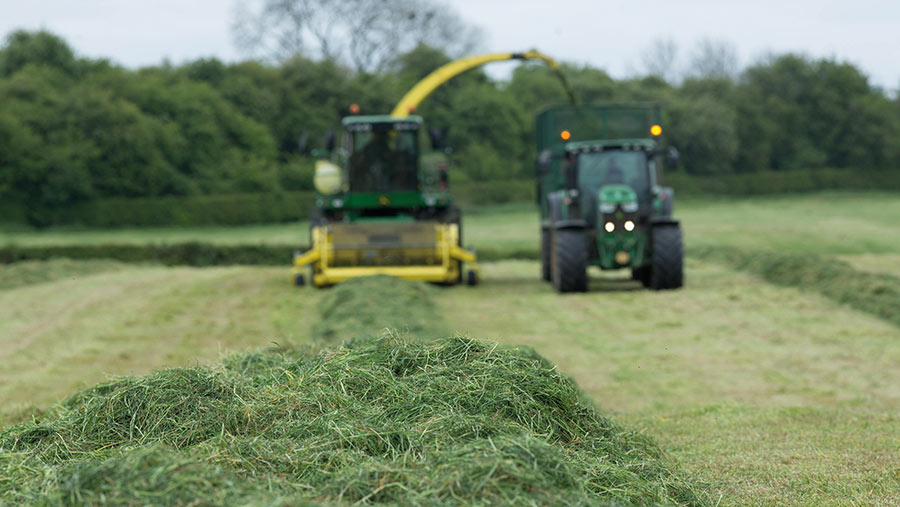How to prepare for the 2023 silage-making season
 © Tim Scrivener
© Tim Scrivener Strike when conditions are right for silaging, regardless of when in the season that occurs.
That is the message from Paul Macer, of Kite Consulting, in the countdown to this year’s forage harvest.
His advice comes as the legacy of last year’s drought continues to impact many livestock farmers.
See also: 8 ways to produce award-winning silage
So, too, does the decision some farmers took to cut back on inputs when confronted by rocketing fertiliser prices.
Those that took this approach, especially early in the season, are in more dire straits than most that carried on as normal, says Mr Macer.
“As I said at the time, the grass doesn’t know the price of fertiliser has gone up and the strategy to keep feeding the grass and the crops has proved to be more important than ever,” he says.
“Although what will stick in everybody’s mind from last year is the dry spell, equally noteworthy was the huge grass potential we had through the latter part of April, all through May and just into the early part of June before dry weather really kicked in.”
Those who took advantage of that had some stocks in hand to help them through the drier period later in the year, he adds.
Using a multicut system to make silage makes the most of that early potential, says Ben Watts, also of Kite Consulting.
“If you get first cut in early and are then cutting every 28-30-odd days, you can get two, if not three, cuts in before drought sets in. That’s been the saviour of many a farm business in the South East,” Ben says.
Rather than scalping the grass, he advises leaving a small residual of grass after each cut so it can use fertiliser applied, protect the soil and retain more moisture.
Top tips ahead of silaging
- Check soil nutrient status
- Test slurry and measure volumes accurately
- Create a full nutrient management plan for each field based on indices and organic manure applications
- Front-load nutrients
- Cut early and regularly
- Measure yields and identify poor-performing fields
- Consider alternative crops for 2023 instead of cutting old leys
- Minimise waste – losses in the field and through fermentation, effluent and deterioration at feed out can total 8-48%
Forage budget
When drawing up a forage budget, Mr Macer advises always considering soil type and summer rainfall.
With input costs still high, he says less productive grass fields might be better suited to maize or a spring wholecrop as a means of boosting this year’s production.
Doing this would also give an opportunity to upgrade leys later in season.
On a freshweight basis, a four-cut system is £4/t more expensive than a three-cut one, according to Kite figures based on strong book values for contractors.
However, in terms of quality and yield, this is where the extra investment in more frequent cutting really starts to pay dividends, he says.
Extra nutrients
“There is an increase in energy and protein from that extra cut, by increasing crude protein levels by 2% and putting 0.8MJ on average quality across the season.
“And obviously, we have higher yield potential as grass is always photosynthesising under a multicut scenario.”
This equates to about 30-40% extra nutrients from a four-cut system.
It is “really significant” in terms of MJ/ha – the equivalent of 1.03t dry matter (DM) of wheat, worth £680/ha in extra energy (priced at £660/t DM), and 0.7t DM of rape, worth £675/ha in extra protein (priced at £964/ha DM).
“You don’t get both of them together, but just one more than pays for the extra investment in contracting and fertiliser costs,” says Mr Macer.
Ride the storm for 2023
Cost of production this year is expected to hover about 42-44p/litre, according to Kite Consulting’s Edward Lott.
In the short term, conditions will be “really challenging,” and marginal litres this spring will carry low value.
However, growth in demand from countries such as Indonesia and Malaysia, as well as China, brings huge opportunities in the longer term.
To ride the storm this year, Mr Lott advises dairy farmers to:
- Hedge risks on feed, fertiliser, energy
- Maximise milk price where possible, for example, through the Arla Sustainability programme
- Have a strategy to keep a positive mindset – going into a challenging time creates pressures, so try and manage your own mental health and positivity within your farm team.
Paul Macer, Edward Lott and Ben Watts were speaking at “Forage Challenge 2023”, a webinar organised by Kite Consulting
